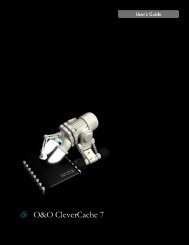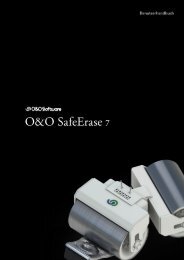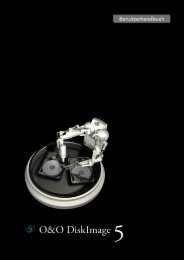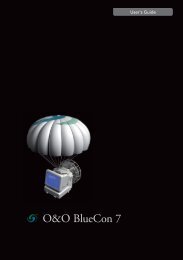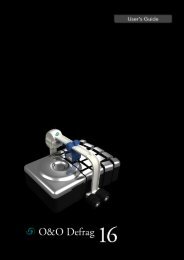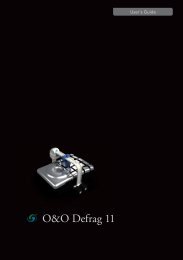O&O DiskImage 7 User's Guide - O&O Software
O&O DiskImage 7 User's Guide - O&O Software
O&O DiskImage 7 User's Guide - O&O Software
You also want an ePaper? Increase the reach of your titles
YUMPU automatically turns print PDFs into web optimized ePapers that Google loves.
Create bootable media<br />
information or use it for acquainting the hard disk to the operating system based on the disk's original information. We<br />
recommend using this function when you want to restore deleted or destroyed data from a forensic image.<br />
Note: Creating a virtual disk out of an entire hard disk can result in recognition problems for the virtual disk when the<br />
following applies to the hard disk being imaged:<br />
- defective or invalid partition tables<br />
- partitioning process not supported by your operating system (e.g. GPT)<br />
- dynamic hard disks containing volumes that are spanned, striped, mirrored or RAID5 when not all the hard disks<br />
being used were imaged<br />
- encrypted hard disk<br />
Technical limitations<br />
- Windows refresh problem: if you're working with a remote desktop connection, a new login will be needed for displaying<br />
the mounted drives.<br />
- Mounting images larger than 2TB is not supported by Windows XP (32-bit).<br />
Note: After restarting from Windows, the virtual drive is removed automatically from the drive list.<br />
Mount ISO file as drive<br />
If you have saved data as an ISO file, you can mount this ISO file as drive and view the files it contains. This allows<br />
you to copy individual files and folders from the ISO file onto existing drives. It is, however, not possible to make<br />
changes (such as deleting or adding files) to the virtual hard disk mounted from the ISO file.<br />
1. Open Tools in the menu bar and select the option Mount ISO file as drive.<br />
2. Select the ISO file (*.iso), whose content you want to mount as a drive.<br />
3. After selecting the ISO file, click Mount ISO file. If you want to label it with a certain letter, you can select<br />
another letter from the list.<br />
4. Refreshing can take a few moments.<br />
5. The virtual drive from the ISO file will then be visible as a regular drive in the Windows Explorer.<br />
Tip: If you want the virtual drive to also be visible in the O&O <strong>DiskImage</strong> drive list, make sure to check Include CD<br />
and DVD drives under Program settings/General and click Show drives not able to be imaged under View.<br />
Note: After restarting from Windows, the virtual drive is removed automatically from the drive list.<br />
O&O <strong>DiskImage</strong>-68



